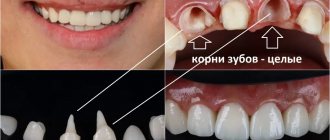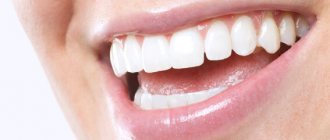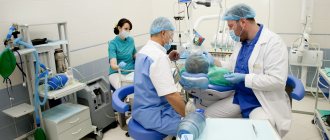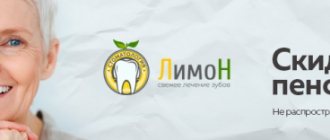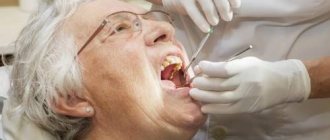About 50% of those who use removable dentures in everyday life indicate that the main problem in their use is insufficient strength of fixation in the oral cavity. This feature is the reason that when performing certain actions (eating, talking, laughing), the prosthesis can noticeably shift relative to its normal position.
To avoid such troubles, it is recommended to use special means that ensure high-quality fixation of dentures in the oral cavity.
Typically, when it comes to nylon and acrylic dentures, creams and gels are used. Gels are not inferior to creams in their functionality and differ from them only in consistency. Creams have a denser structure and are better suited for those who are just starting to use removable dentures.
Below we will consider the main means that are used for reliable and long-term fixation of dentures, their advantages and disadvantages.
ROCS
This drug was manufactured jointly by Russian and Swiss specialists and provides twelve-hour reliable fastening of the prosthesis, independent of the consumption of heated drinks and food.
Being distributed over the inner surface of the structure, this cream prevents small food particles from getting under the surface of the prosthesis. It should also be noted that the composition of this cream includes mint and menthol extracts, which significantly freshen breath and prevent the occurrence of unwanted odors.
Advantages
- Hydrophobicity. Cannot be washed off with any liquids.
- Lack of zinc element.
- Possibility of application to wet (not dried) dentures.
- The cream does not contain any artificial dyes or additives.
- Able to withstand the thermal effects of food, as well as drinks.
Flaws
- A high degree of thickness, which in some cases can complicate the uniform application of the cream.
- High price of the product.
In retail trade, the price for ROKS ranges from 250 to 400 rubles.
How to make teething easier
While the teeth are just getting ready to appear, the baby experiences a lot of unpleasant sensations, which, of course, causes a lot of trouble for the parents. During this period, the child needs care and affection, as well as plenty of fluids. It is recommended that infants be breastfed more often, and children on artificial nutrition should be offered more warm water.
There are many ways to relieve discomfort. Two most popular:
- Give your child special teethers - these are soft silicone toys filled with liquid. Cool the toy slightly in the refrigerator before use. This will help relieve swelling and reduce pain. The textured surface of the teether will give the baby the opportunity to thoroughly massage and “scratch” the gums. The bright design of the toy will attract attention to it and amuse the child.
- Use topical medications - pain-relieving gels and ointments for gums, designed specifically for children. These remedies act very quickly and help the child forget about discomfort for several hours.
Lacalut
Lacalut is a product of German technology of traditionally high quality. This cream, according to manufacturers, is capable of providing reliable adhesion of the prosthesis to the oral cavity for a period of more than 24 hours.
The cream forms a protective layer between the patient’s mucosa and the prosthesis, which effectively protects the oral cavity from potential injuries and rubbing by the edges of the prosthesis. This is especially true for those who have just started using removable dentures.
Lacalut cream contains a substance called aluminum lactate, which has a pronounced anti-inflammatory effect. This cream can be applied not only to dried, but also to moistened removable dentures.
Advantages
- Provides gentle operation of prostheses, minimizing possible injuries and abrasions in the process.
- It has a pleasant taste and aroma.
- Provides reliable long-term fixation of the prosthesis.
Flaws
- There may be a slight weakening of the fastening strength during the consumption of various hot foods or drinks, such as tea or coffee.
- Relatively high price.
The cost of Lacalut adhesive cream ranges from 300 to 450 rubles.
Medical Internet conferences
Substances for treating root canals must meet certain requirements: 1. Be bactericidal for microorganisms located in the root canals; 2.Have a quick effect and penetrate deeply into the dentinal tubules; 3.Do not lose its effectiveness in the presence of organic substances; 4.Do not have a smell or specific taste; 5.Be chemically resistant and remain active during long-term storage; 6.Be harmless to periapical tissues and promote their regeneration; 7.Do not have a sensitizing effect and do not cause the emergence of resistant forms of microorganisms. Basic provisions justifying the need for disinfection of root canals: 1. Complex anatomy of root canals, which provides a favorable environment for the growth, reproduction and interaction of microorganisms; 2. In teeth with necrotic pulp and inflammation of the root apex, gram-negative anaerobes predominate; 3. Microorganisms are present in all areas of the root canal, including lateral canals, anastomoses and dentinal tubules at a depth of up to 300 µm; 4. Microorganisms receive nutrition from living or necrotic pulp, salivary proteins and periodontal tissue fluid, and from other bacteria; 5. The waste products of microorganisms negatively affect pulp tissue and are toxic to periodontal tissue. Classification of antiseptics for root canal treatment: 1. Halides 2. Oxidizing agents 3. Nitrofuran preparations 4. Quaternary ammonium compounds 5. Urea or urea 6. Proteolytic enzymes 7. Complexones (chelates). Halides include two types of drugs - chlorine-containing and iodine-containing. Chlorine-containing preparations are presented: 0.05-0.06% chlorhexidine solution, 2-4% chloramine B solution, 1-5% sodium hypochlorite solution, 2% aqueous solution of chloramine T. The mechanism of action of these drugs is based on the release of chlorine gas, which penetrates into the dentinal tubules, disinfecting their contents and destroying organic residues. The most common drug in this group is sodium hypochlorite . The drug was first proposed by G. Deyikn as a wound disinfectant during the First World War, and only a few years later this antiseptic began to be used for root canal irrigation. It has a number of properties that have made it so popular in endodontics: the unique ability to dissolve the organic contents of root canals: necrotic tissue, decay products, scraps of extirpated pulp; pH values range from 11 to 12; pronounced antimicrobial effectiveness, bactericidal effect, consisting in the oxidation and hydrolysis of proteins in microbial cells; is a good lubricant; chemically resistant; has whitening properties; economically beneficial. Sodium hypochlorite, when interacting with tissue proteins, quickly disintegrates, releasing atomic chlorine, which combines with amino groups to form a substance called chloramine and, as a result of the resulting reactions, peptide bonds are broken, proteins dissolve, and do not coagulate, as with the action of other disinfectants. As a result, chloramine disinfects the root canal, which has already been cleared of organic matter, and also dissolves the contents of the lateral tubules or apical delta, which cannot be processed instrumentally. The negative properties of sodium hypochlorite, as well as various other chlorine-containing compounds, are the following: decreased activity in the presence of organic substances, which makes it necessary to re-rinse the root canals; have an irritating effect on periodontal tissue; have a specific, unpleasant odor. It is presented on the market in the form of preparations: Edetal gel (5 ml Omega-Dent, Russia), Parkan (250 ml, Septodont, France), Belodez (30 ml, 100 ml Vladmiva, Russia). Iodine-containing include : 1% aqueous solution of iodinol containing iodine, potassium iodide, polyvinyl alcohol, distilled water. The drug has bactericidal and fungicidal properties due to the action of molecular iodine, it also accelerates regeneration and phagocytosis, has a prolonged effect and is also an indicator of the cleanliness of the root canal (the drug has a blue tint, but upon contact with necrotic tissues, discoloration occurs). A well-known representative of the group of oxidizing agents is hydrogen peroxide, used in the form of a 3% solution. Hydrogen peroxide has a bactericidal effect due to the release of molecular oxygen upon contact with organic tissues, especially against gram-negative microflora. The advantage of this substance is also its hemostatic properties. The disadvantage of a 3% hydrogen peroxide solution is the lack of ability to dissolve necrotic tissue and organic residues, therefore it is recommended to alternately use solutions of hydrogen peroxide and sodium hypochlorite; the interaction reaction between these substances leads to the release of free chlorine and oxygen, which enhances the cleansing and bactericidal properties of these substances. Quaternary ammonium compounds. Includes 1% decamin solution , 15% decamintoxin, biosept. These drugs have bactericidal, bacteriostatic and fungicidal effects, are active in the presence of organic substances, have an anesthetic effect and enhance the effect of other antiseptics. In endodontic practice, drugs based on urea (carbamide) , for example the drug Cly-oxide , the drug is a 10% solution of urea peroxide in glycerin. In addition to the lack of toxicity, the drugs have an antiseptic effect, lyse necrotic tissue, and also potentiate the effect of antibiotics. Drugs of the nitrofuran series include 0.5% solution of furatsilin , 0.1-0.15% solution of furadonin, furagin, furazolidone. The positive properties of these substances include their bactericidal effect on gram-positive and gram-negative microflora, as well as on fungi, stimulate phagocytosis and have an anti-exudative effect. A group of proteolytic enzymes. This group includes preparations of trypsin and chemotrypsin , which are prepared immediately before use - ex temporae, by diluting the crystals in a 0.9% isotonic solution of sodium chloride or 0.5% novocaine solution. This group also includes immobilized enzymes - stomatozyme, immozymase, produced in the form of a gel, ready for use. Proteolytic enzymes are capable of lysing necrotic tissue, have an anti-inflammatory and anti-exudative effect, have an anticoagulant effect, and also deprive microorganisms of a nutrient medium due to which they exhibit an indirect bacteriostatic effect. But despite a number of positive properties, these root canal treatment products often lead to the development of allergic reactions and are also quickly inactivated.
Comparative table of the main properties of representatives of the main groups of antiseptics for root canal treatment:
| Antiseptics | Bactericidal | Toxicity | Having an unpleasant odor or taste | Action in the presence of org. substances | Efficiency |
| Sodium hypochlorite | +++ | +++ | +++ | +++ | +++ |
| Hydrogen peroxide | +++ | ++ | — | — | ++ |
| Chlorhexidine | +++ | — | — | +++ | ++ |
| Urea | +++ | — | + | +++ | ++ |
Unfortunately, today antiseptic solutions of the nitrofuran series have lost their importance in endodontic practice, as some strains of microorganisms have developed resistance to nitrofurans, which has led to a sharp drop in the effectiveness of these drugs. It should be said that an analysis of medical records of dental patients allows us to draw conclusions that the use of sodium hypochlorite in endodontics gives better results than other disinfectants, which is due to the distinctive abilities of its antimicrobial action. It is important to remember that when working with this substance, it is necessary to strictly observe all safety measures: rubber dam, saliva ejector, vacuum cleaner, in order to avoid contact of the antiseptic with the oral mucosa. Complications associated with the use of the drug occur, first of all, due to the release of the drug beyond the top of the canal, which leads to the development of swelling, bleeding, pain, and in some cases, the development of parasthesia and secondary infection is possible.
Based on the material presented, we can conclude that in modern endodontics there is no universal remedy that fully meets all the requirements and is capable of destroying all the diverse microflora found in infected dental tissues; but we can definitely say that medical treatment of root canals using antiseptics is an important stage of endodontic treatment and allows you to avoid possible dangerous complications not only on the tissue of the maxillofacial area, but also on the entire body as a whole.
"Protefix"
The cream of this brand ensures reliable fastening of the removable structure for up to 14 hours. Three different types of this product are produced, one of which, due to the absence of any foreign dyes and flavoring additives in its composition, is hypoallergenic.
Advantages
- Complete absence of foreign tastes and odors.
- High reliability of fixation.
- Economical.
Flaws
- Due to its liquid consistency, the fixative may leak out of the bottle if it is not held strictly vertically.
- Not a particularly convenient dosing system.
The cost of this drug varies depending on the volume of the tube, usually ranging from 150 to 390 rubles.
How to rinse your mouth correctly
In many ways, the results of the procedure are determined by the correctness of its implementation. These are the basic rules that dentists are asked to adhere to:
- Regularity. There is no point in rinsing your teeth and gums only when the urge arises. If the dentist says to use the solution every few hours, that’s what you should do. Otherwise, it will not be possible to achieve positive dynamics.
- Under no circumstances should the prepared medicine The optimal temperature is 36-40 degrees Celsius. If a hotter liquid is used, the affected area will heat up, and high temperatures are known to create suitable conditions for the further spread of pathogenic organisms.
- Do not swallow antiseptic. Most of the drugs in the group presented on the pharmaceutical market are not intended for internal use. They negatively affect the functioning of the gastrointestinal tract.
- You don’t just need to take the solution into your mouth and immediately spit it out, but hold it in the area of the affected tissue for about a minute. Such mouth baths are considered the most effective.
Using antiseptics wisely and giving preference to proven means, you can significantly bring recovery closer even with advanced dental diseases.
"Fittydent"
"Fittident" is considered one of the best drugs for fixing dentures in the oral cavity , however, if the patient has increased sensitivity of the mucous membranes, then during the periods when "Fittident" is used, unpleasant sensations such as burning and/or characteristic tingling sensation.
To ensure that these side effects are avoided, after the cream is applied, let it dry for about half a minute.
Advantages
- Long fixation time provided by this drug.
- Lack of distinct taste.
- After removing the denture, no traces of cream remain in the patient’s mouth.
Flaws
- Difficult to find in city pharmacies in small towns.
- The cream must be applied exclusively to the dry surface of the prosthesis.
- Very thick structure of the drug.
The cost ranges around 270 rubles.
How to prevent or relieve gum disease
After installation of dentures, both fixed and removable, discomfort may occur in the mouth. The reason is that the gums are not yet accustomed to the structures, and because of this, redness and swelling occur.
It is important to prevent the inflammatory process, and this can be done with the help of medications or folk remedies:
- Camomile tea. To prepare, take 1 tbsp. spoon of dried herb, pour boiling water and leave for 10-20 minutes. Rinse your mouth with the cooled infusion every 3 hours.
- Sage. Prepare the infusion in the same way or following the instructions on the package. It has an antimicrobial effect, therefore relieves inflammation and is safe for dentures.
- Oak bark decoction. Improves the condition of the gums in general, strengthening them and relieving inflammation.
- Salt + soda + water. A teaspoon of salt and soda per glass. This solution anesthetizes and disinfects.
- "Rotokan" is an inexpensive liquid herbal extract, sold in pharmacies. Dilute with water in the proportion specified in the instructions and rinse your mouth after each meal.
Medicinal herbs and antiseptic drugs prevent inflammation, relieve pain, stop bleeding, and avoid tissue infection as a result of rubbing with dentures. However, if there is bleeding and inflammation due to dentures, it is best to use proven products such as ASEPTA® Parodontal products.
"The president"
The prosthesis attached with this drug tightly adheres to the mucous membrane due to the formation of an elastic layer of high density, which prevents food particles from entering under the surface of the prosthesis.
The consumption of hot drinks, as well as food, in some cases can lead to a weakening of the fixing strength.
Advantages
- Larger volume compared to analogues.
- High strength of prosthesis fixation.
- Low cost of the product.
Flaws
- Strong foreign taste.
- Eating can weaken (sometimes quite significantly) the fixation.
The cost of the drug is approximately 250 rubles.
"Korega"
All components of fixing preparations from this manufacturer are hypoallergenic and do not cause any side effects when used as intended.
Advantages
- Corega cream is equally suitable for use with both dry and wet dentures.
- It is characterized by low allergic activity and ease of use.
- It has a very low cost.
Flaws
- A short period of full fastening, which does not exceed four hours.
- Not waterproof, washes off quickly.
- It comes to an end pretty quickly.
- During the absorption of food, the prosthesis may fall out due to the dissolution of this product.
- If you use Corega cream for quite a long time, swelling of the mucous membrane may develop.
The average cost of this cream does not exceed 300 rubles.
We would also like to note that in case of any complications associated with the use of dentures, you should immediately contact the VivaDent clinic.
The effectiveness of baby gels for gums, how to use them when teething
Before buying this or that gel, consult your doctor to be sure of the safety and effectiveness of the product. Be sure to read the instructions before first use.
Basic rules for using gum gel when teething in a child:
- Apply the gel using a sterile cotton swab or very carefully with clean fingers.
- The product must be rubbed in slowly in a circular motion.
- Remember that a very small amount of gel is enough. Do not overdo it.
- The product can be used no more than four to five times a day, with a minimum interval of four hours between applications.
- Gels should only be used in cases of severe pain or discomfort. Usually the most painful teeth are the first two incisors and those that appear in the second year of life.
